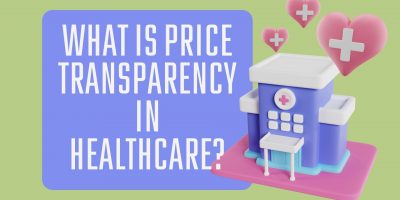
How Do Disease Prevention Programs Try to Reduce Cardiovascular Disease?
As a healthy workforce represents a healthy society and vice versa, it’s paramount for cardiovascular disease prevention to find its place in the workplace.

In today’s consumerist world, browsing, weighing options, and shopping for the best deal is common among Americans. Yet, this experience is often missing in the realm of the most crucial aspect–healthcare.
Despite the abundance of information readily available, consumers have been left in the dark when it comes to the financial cost of medical treatments and procedures for far too long. With the continued rise of healthcare costs, understanding the true cost of healthcare services is becoming more critical than ever.
Fortunately, there has been a bipartisan effort to address this issue over the past decade. Several healthcare transparency laws have been introduced in an attempt to lift the veil of secrecy and help Americans make better-informed decisions.
This article explains the newly implemented healthcare price transparency acts and the impacts of making healthcare costs public and offers ideas of how transparency can help people get the care they need.
Imagine knowing the price of a medical procedure before you even step foot in the doctor’s office. The recent healthcare price transparency acts and reforms aim to do that – to give patients the power to make informed decisions about their health and their wallets.
As stated in former President Trump’s Executive Order, titled “Improving Price and Quality Transparency in American Healthcare to Put Patients First”: “To make fully informed decisions about their health care, patients must know the price and quality of a good or service in advance.”
However, the Executive Order notes that “patients often lack both access to useful price and quality information and the incentives to find low-cost, high-quality care.” The lack of this information is widely considered one of the underlying issues contributing to the dysfunction within the US healthcare system.
Hence, the American health system is entering a new era of transparency.

After decades of negotiations between health insurance brokers and healthcare providers, Americans can now access negotiated prices before receiving care.
Since the fall of 2019, the federal government has implemented several significant regulations on price transparency, including the Hospital Price Transparency Rule, the Transparency in Coverage Rule, and the No Surprises Act.
These regulations have imposed unprecedented obligations on hospitals and health insurers to make their previously confidential pricing information publicly accessible online.
The problem with the current system is that healthcare prices are disconnected from market forces. Insurers negotiate with providers behind closed doors, determining how much they will pay for a given service.
As a result, patients are uninformed regarding the actual cost of their care.
They may be responsible for thousands of dollars in out-of-pocket expenses through a deductible and are often limited to a specific network of providers, even if those providers are not the lowest cost or best quality.
So, why is transparency in healthcare important?
Transparency in healthcare is essential for creating a more equitable and efficient healthcare system where patients are informed and empowered to make decisions about their health. With healthcare spending averaging $11,582 per American, it’s more important than ever to find ways to minimize costs.
One area where price transparency is especially beneficial is for “shoppable” services such as primary care appointments, x-rays, laboratory tests, and routine surgeries.
However, findings have shown that the same procedure can have vastly different costs from hospital to hospital and even from patient to patient.
The prices of certain services, such as knee and hip replacements, cholesterol tests, and Magnetic Resonance Imaging (MRIs) can vary significantly even within a specific geographic area.
A 2018 study by the Kaiser Family Foundation found that allowed in-network charges for joint replacements varied widely between geographical regions, from an average cost as low as $23,170 in Maryland to as high as $58,193 in New York and New Jersey. A CT scan of the head in the state of Wisconsin can range in price from $858 to $2,803.
This staggering difference in cost raises the question of whether higher prices genuinely lead to a higher quality of care or outcomes.
Initial calculations show an average of an 800% variation in the cost of common procedures within the same geography, highlighting the need for transparency in healthcare.
By giving patients visibility into cash pay rates and health insurance rates, hospital rate transparency empowers patients to shop smart and take control of their healthcare costs like never before.
The high cost of healthcare has become such a concern that a staggering four in ten Americans have reported avoiding medical care in order to save money, according to a Gallup poll. Without a true healthcare marketplace that prioritizes price transparency, the costs for all will continue to spiral out of control.
The question arises, are the benefits of price transparency in healthcare really that significant?
If healthcare costs are transparent, it could have a strong positive effect on the health and wellness of individuals. Consumers could make better-informed decisions about their health and well-being and, at the same time, save money.
For example, one comprehensive study that evaluated the impact of a cost-comparison tool for Magnetic Resonance Imaging (MRI) prices in New Hampshire from 2005 to 2011 revealed that patients who used the tool experienced reductions in out-of-pocket costs of up to 11%.

By mandating the disclosure of price and benefit information directly to consumers and the public, the transparency requirements will deliver a range of benefits for consumers, including:
Ultimately, by knowing the cost of healthcare, people would be more likely to proactively seek preventative treatments and lifestyle changes rather than waiting until their health deteriorates and driving up their expenses.
Transparency could create a more equal, efficient, and economical healthcare system.
Gone are the days of blindly accepting bills from healthcare providers. As healthcare consumers become increasingly savvy, they demand greater transparency about their medical treatments’ costs.
Disruptors are entering the market and taking advantage of publicly available data to create customer-friendly shopping tools for healthcare services. A set of innovative healthcare price transparency solutions, including calculators and other price estimator tools, are being introduced to give patients a clear, accurate picture of their financial obligation for medical services.
Healthcare price transparency tools empower patients to take control of their medical expenses by giving them access to real-time pricing information for medical procedures, treatments, and prescription drugs. With this information at their fingertips, patients can compare prices between providers, negotiate with their insurance companies, and ultimately make more educated decisions about their care.
However, the benefits of consumer-friendly tools extend beyond just cost savings. These tools also provide patients with valuable information about the quality of care offered by different providers, allowing them to make an informed choice about where to receive treatment. This is especially important for patients who require disease management for chronic conditions or those seeking specialized care.
The use of price transparency tools also benefits health care providers.
By providing patients with accurate cost estimates, providers can reduce confusion and dissatisfaction among patients. Additionally, these calculators can display which healthcare institutions comply with CMS requirements and regulations.
As part of a broader set of health plan price transparency rules, Phase 1 of the latest Transparency in Coverage Final Rule was enforced on July 1, 2022.
Starting July 1, 2022, most group health plans and issuers of group or individual health insurance are required to post pricing information for covered items and services.
Issued by the Centers for Medicare and Medicaid Services (CMS), this rule aims to help consumers make well-informed decisions when choosing a healthcare service provider by being transparent in its pricing.
According to the Coverage Rule Fact Sheet from CMS, these requirements are an extension of previous efforts by the federal government to improve medical price transparency for patients. They require hospitals to disclose their standard charges, including negotiated rates with third-party payers, giving patients greater access to hospital pricing information.
The Transparency in Coverage rule will go into effect in three stages, with Phases 2 and 3 starting in 2023 and 2024. As more requirements go into effect beginning January 1, 2023, and January 1, 2024, there will be even more access to pricing information, giving consumers even more power to shop for the healthcare that best meets their needs.
The Healthcare Price Transparency Act came into effect on January 1, 2021, and requires hospitals to publish their rates in two ways:
The price transparency requirements are meant to provide greater visibility into pricing information, but healthcare organizations have been struggling to meet these requirements.
Despite advancements in healthcare transparency, it is crucial to remember that these benefits will only be realized if healthcare providers comply with new regulations. Unfortunately, recent data on compliance with price transparency requirements is alarming.
One report found that only 14% of hospitals complied with the rule from December 2021 to January 2022.
Manatt Health data also revealed that hospitals have had difficulty meeting the machine-readable file requirement, with only 12% fully implementing it and 19% not implementing it at all.
Hospitals may face financial penalties if their websites do not comply with these requirements. Under the CY 2022 Hospital Outpatient Prospective Payment System (OPPS), smaller hospitals will receive a penalty of $300 per day, while larger hospitals will face a penalty of $10 per bed per day, with a maximum fine of $5,500.
Despite these penalties, some hospitals may still consider non-compliance, but CMS clarified that non-compliance could result in the loss of Medicare payments.
In a bid to make healthcare more affordable and accessible, the US government has introduced several new regulations aimed at increasing price transparency in the industry.
Under the Hospital Price Transparency Final Rule, each US hospital must publish clear and accessible pricing information for 300 “shoppable” services online in a consumer-friendly format.
This information must be easily accessible, requiring no login or personal health information for access. Hospitals must also publish a machine-readable file containing rates for all services, not just shoppable ones.
On the other hand, the Transparency in Coverage Final Rule requires that health plans and self-insured employers must reveal comprehensive cost and pricing information to consumers and other parties.
As of July 1, 2022, health plans are mandated to release three publicly accessible, machine-readable files that are refreshed monthly that contain information on in-network provider negotiated rates, drug pricing, and historical out-of-network allowed amounts.
By January 1, 2023, health plans must have an online self-service tool in place for members with specific search functionality displaying pricing and cost-sharing information for 500 shoppable services specified by CMS. Lastly, by January 1, 2024, health plans must use the same online tool to provide pricing and cost-sharing information for all services.
In addition, to help prevent surprise medical bills, the government has introduced the No Surprises Act. The new rule provisions include requiring all emergency services to be treated as in-network services, prohibiting high out-of-network cost-sharing for emergency and non-emergency services, and physicians provide clear, advanced notice about out-of-network charges to consumers.
Undeniably, healthcare costs are exorbitantly high and continue to grow.
Over the past two decades, Americans have ’ witnessed a 200% increase in hospital service prices. The reality is that one unexpected medical event can lead to financial ruin, as medical bills have been the leading cause of bankruptcy in the United States for years.
While having health insurance coverage may seem like a safety net, it doesn’t necessarily protect against the financial burden of overwhelming medical bills. As shown by one survey, a staggering 47% of insured adults reported struggling to pay for out-of-pocket costs, and an alarming 33% of patients say they can’t afford their deductibles.
The first step to creating a change in healthcare is through pricing clarity.
Studies have shown that price transparency can significantly impact healthcare costs. In 2014, an employer-sponsored price transparency platform was associated with lower spending for standard procedures.
Moreover, the biggest beneficiaries of this system are employers who provide coverage to approximately 160 million employees and their dependents. With an understanding of insurer-negotiated prices, self-insured employers can demand lower prices and improve networks through larger providers.
In the past, medical billing was a labyrinth of complex codes and charges, leaving many consumers feeling confused and overwhelmed.
With healthcare price transparency acts, consumers are better prepared and informed about the cost of healthcare services or items before they receive them. In return, this increased transparency builds trust between patients and their medical providers. It also puts pressure on insurance companies and healthcare systems to be more efficient and customer-centric in a new, more competitive marketplace.
However, transparency is not the end goal.
To truly improve healthcare, we need both price transparency and patients who are motivated to find high-quality, low-cost providers. This combination can serve as a catalyst for better decision-making by patients, providers, and payers alike.
With greater price transparency, patients can shop for the clinician with the best value, while doctors can use pricing data to help patients evaluate their options. Employers, providers, and payers will also have new tools to negotiate lower prices or accelerate value-based payment.

The Healthcare Price Transparency Act is not just a simple price transparency regulation, but a giant leap towards a new healthcare paradigm where consumer empowerment, population health, and health equity are at the forefront.
Senior Content Writer at Shortlister
Browse our curated list of vendors to find the best solution for your needs.
Subscribe to our newsletter for the latest trends, expert tips, and workplace insights!

As a healthy workforce represents a healthy society and vice versa, it’s paramount for cardiovascular disease prevention to find its place in the workplace.

Delve into the importance and challenges of price transparency, exploring its crucial significance for patients, providers, and the overarching healthcare system.

As we explore the value of regular health screenings, cost-effectiveness emerges as a major benefit for individuals, companies, and society.

In response to the demand for an improved consumer experience, both employers and insurers recognized and addressed the need for health advocacy programs.
Used by most of the top employee benefits consultants in the US, Shortlister is where you can find, research and select HR and benefits vendors for your clients.
Shortlister helps you reach your ideal prospects. Claim your free account to control your message and receive employer, consultant and health plan leads.